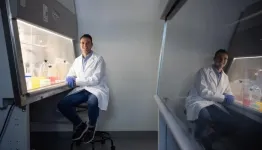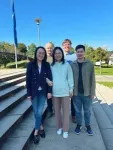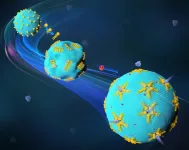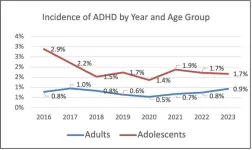(Press-News.org) CRISPR is a powerful gene-editing tool that holds enormous potential for treating genetic diseases by allowing scientists to cut, replace, or delete mutations in DNA. It can also modify gene expression, temporarily amplifying or diminishing its effects.
Yet, despite its promise, applying CRISPR (which is a reagent, or a substance that facilitates a reaction) in patients presents significant challenges.
“CRISPR is difficult to control when you want to do gene editing in vivo, or directly in the patient,” says Tomas Gonzalez-Fernandez, an assistant professor of bioengineering in Lehigh University’s P.C. Rossin College of Engineering and Applied Science. “In this case, it’s typically administered as a systemic injection, meaning it circulates throughout the entire body and can have adverse effects on areas other than the target tissue. It’s important to control where CRISPR goes, and when the CRISPR action takes place, so it doesn’t cause problems elsewhere in the body.”
Gonzalez-Fernandez recently secured funding through the National Science Foundation’s Faculty Early Career Development Program (CAREER) for his research that will explore how combining CRISPR with biomaterials can make the technology both safer and more effective for therapeutic use.
The prestigious NSF CAREER award is given annually to early-career faculty members across the U.S. who exemplify the role of teacher-scholars through outstanding research, excellent education, and the integration of education and research. Each award provides stable support at the level of approximately $500,000 for a five-year period.
Through laboratory experiments, Gonzalez-Fernandez and his team will investigate using hydrogels to help guide the technology to the appropriate target and dictate the timing of the CRISPR action—in other words, controlling where and when the therapy takes place. They’ll first study what happens when the biomaterial and CRISPR first come in contact.
“We want to better understand that interplay, and how we can optimize biomaterial properties, such as charge and porosity, to better control CRISPR delivery,” he says.
After that, they’ll examine how these encapsulated or functionalized materials interact with human cells.
“That’s the higher level of complexity we need to understand,” he says. “How does the interaction between these materials and cells influence the gene editing efficiency of CRISPR?”
To date, says Gonzalez-Fernandez, there has been very little research into how biomaterials could enhance CRISPR delivery. As such, this will be one of the first studies to study how both biomaterial design parameters and cell interactions affect CRISPR efficiency.
The ultimate goal is to design safer, more efficient therapeutics that could someday treat genetic diseases, including cancer, sickle cell anemia, cystic fibrosis, Alzheimer’s, Duchnene muscular dystrophy (DMD), and other chronic musculoskeletal disorders.
The FDA recently approved CRISPR to treat sickle cell disease, an inherited disorder that causes red blood cells to deform and block blood flow and can cause severe pain. The therapy was done ex vivo, or outside the body, and the modified cells were then implanted back into the patient.
“This was the first approved CRISPR therapy, and it was a huge success for sickle cell anemia,” says Gonzalez-Fernandez. “But it was all done in the lab, which requires highly specialized facilities.”
He notes, too, that a recent clinical trial where CRISPR was injected virally directly into a patient with DMD caused a fatal immunological response.
“The challenge is how can we make this therapeutic safer?” he says. “My answer for that is to use biomaterials. They can help pave the way for more localized therapies.”
The CAREER award is validation of that belief.
“It feels good to know that the scientific community appreciates the direction my lab is going in, and the type of science I want to do,” he says.
Beyond the lab, he’s also designing an outreach initiative to engage high school students through what he calls “CRISPR in a Box.” With support from the CAREER award, he will design simple, hands-on experiments to demonstrate how CRISPR can edit genes in bacteria— demystifying the technology and sparking curiosity in the process.
Gonzalez-Fernandez, also runs a YouTube channel, and as part of the grant will leverage the channel to further explain engineering concepts of human physiology to increase public understanding of gene editing technologies.
“Research has shown that people are against CRISPR, not because they’re inherently afraid of it, but because they don’t understand it. If we can better inform the public about what it is, and how we can make it safer and more efficient, we can ultimately increase acceptance of the technology.”
About Tomas Gonzalez-Fernandez
Tomas Gonzalez-Fernandez, an assistant professor of bioengineering in Lehigh University’s P.C. Rossin College of Engineering and Applied Science, leads research at the intersection of synthetic biology, biomaterials, and tissue engineering. His work focuses on developing smart materials and stem cell-based strategies to enhance the regeneration of musculoskeletal tissues, including bone, cartilage, and tendon. In his lab, Gonzalez-Fernandez integrates cutting-edge technologies such as CRISPR/Cas9, 3D printing, and novel bioinks to explore applications like in situ gene editing for tissue repair, engineering immunomodulatory cells and materials, and advancing 3D and 4D bioprinting of functional tissue grafts.
Gonzalez-Fernandez earned his PhD in mechanical and manufacturing engineering from Trinity College Dublin (Ireland), where he specialized in combining non-viral gene therapy with 3D bioprinting for tissue regeneration. He continued his research as a postdoctoral fellow at the University of California, Davis, where he investigated biomaterial functionalization for bone and cartilage repair, earning recognition as a Rising Star in Engineering and Health by Columbia University.
Alongside his research, Gonzalez-Fernandez contributes to professional organizations such as BMES and ORS, serves on Lehigh's DEI council, and co-chairs the university’s Faculty and Staff Pride Network.
Related Links:
Faculty Profile: Tomas Gonzalez-Fernandez
Tomas Gonzalez-Fernandez Lab: Advanced Tools for Engineering Smart Cells and Materials
NSF Award Abstract (# 2441592): CAREER: Multilevel Understanding of Biomaterial-Guided CRISPR Delivery
YouTube: Prof. Tomas Gonzalez-Fernandez
Institute for Functional Materials and Devices
END
Integrating CRISPR and biomaterials engineering: Paving the way for safer gene therapies
Lehigh University bioengineering researcher Tomas Gonzalez-Fernandez receives prestigious NSF CAREER award to address the challenges of gene editing through the use of hydrogels and advanced materials
2025-01-13
ELSE PRESS RELEASES FROM THIS DATE:
New tool for synthetic biology
2025-01-13
Scientists at the University of Stuttgart have succeeded in controlling the structure and function of biological membranes with the help of "DNA origami". The system they developed may facilitate the transportation of large therapeutic loads into cells. This opens up a new way for the targeted administration of medication and other therapeutic interventions. Thus, a very valuable instrument can be added to the toolbox of synthetic biology. Prof. Laura Na Liu and her team published their findings in the journal Nature Materials (DOI: 10.1038/s41563-024-02075-9).
The ...
Yu & Martin adapting mixed reality training programs to real-world scenes to enhance human-AI teaming in emergency responses
2025-01-13
Lap Fai (Craig) Yu, Associate Professor, Computer Science, College of Engineering and Computing, and Joel Martin, Associate Professor, Kinesiology, College of Education and Human Development, received funding for the project: “EAGER: TaskDCL: Adapting Mixed Reality Training Programs to Real-World Scenes to enhance Human-AI Teaming in Emergency Responses.”
This EArly-concept Grant for Exploratory Research (EAGER) project funds research that intends to speed up the development of mixed reality and artificial intelligence (AI) technologies to help ...
ExxonMobil donates $10 million to fund MD Anderson-led Be Well™ Beaumont initiative
2025-01-13
HOUSTON and BEAUMONT, TEXAS ― In an effort to improve public health and reduce cancer risk in East Texas, leaders in Beaumont are working with The University of Texas MD Anderson Cancer Center to launch Be Well™ Beaumont through a newly announced $10 million gift from ExxonMobil. Community members, collaborators and representatives from MD Anderson kicked off the 10-year initiative today in Beaumont.
Be Well Beaumont aims to promote wellness and to lower cancer risk among community members by providing them with cancer prevention education and tools. ...
Long reads successfully used to find genetic causes of rare diseases
2025-01-13
The cause of rare diseases is increasingly being detected through genome sequencing, which involves reading the entire human DNA by first breaking it into small pieces—short reads. Christian Gilissen, Lisenka Vissers, and colleagues found that a new technique using long reads is even more effective at detecting complex causes. They report that eighty to ninety percent of cases were detectable, as stated in the American Journal of Human Genetics.
Rare diseases are typically due to genetic causes. These causes are more and ...
X-ray flashes from a nearby supermassive black hole accelerate mysteriously
2025-01-13
One supermassive black hole has kept astronomers glued to their scopes for the last several years. First came a surprise disappearance, and now, a precarious spinning act.
The black hole in question is 1ES 1927+654, which is about as massive as a million suns and sits in a galaxy that is 100 million light-years away. In 2018, astronomers at MIT and elsewhere observed that the black hole’s corona — a cloud of whirling, white-hot plasma — suddenly disappeared, before reassembling months later. The brief though dramatic shut-off was a first in black hole astronomy.
Members of the MIT team have now caught the same black hole exhibiting ...
New research highlights trends in ADHD diagnoses
2025-01-13
New research identifies differing trends in attention-deficit/hyperactivity disorder (ADHD) diagnoses among adolescents and adults, including an increase among adults from 2020 to 2023. The study, published in the American Psychiatric Association Journal Psychiatric Research and Clinical Practice, found a significant downward trends in ADHD incidence among adults from 2016 to 2020 and adolescents from 2016 to 2018. The ADHD incidence rate remained stable for adolescents in subsequent years.
ADHD is a neurodevelopmental disorder involving inattention and/or hyperactivity and impulsivity that interferes with a person’s functioning and ability ...
United States dementia cases estimated to double by 2060
2025-01-13
A new study shows that the risk of developing dementia anytime after age 55 among Americans is 42%, more than double the risk reported by older studies.
That dementia risk translates into an estimated half-million cases this year, rising to 1 million new cases a year by 2060, according to the new work. Dementia involves progressive declines in memory, concentration, and judgment. The increasing number of cases is directly tied to the aging of the U.S. population. Beyond aging, a high risk of dementia is linked to genetic factors, as well as high rates of hypertension and diabetes, obesity, unhealthy diets, ...
“The biggest challenge is lacking public acceptance of wind turbines”
2025-01-13
In brief
In their overview study, the team of researchers led by Russell McKenna identified 14 key impact categories of wind energy.
They provide possible solutions for the identified impacts and suggest research priorities. More than 400 studies were included in the analysis.
The review paper, recently published in the journal Joule, provides guidance for future studies and policy decisions.
What is the study about, and what is its core message?
Russell McKenna: The study looks at the impacts of wind energy on the systems in which it is embedded; whether environmental and climate systems, socio-economic, ...
Six-month outcomes in the long-term outcomes after the multisystem inflammatory syndrome in children study
2025-01-13
About The Study: The results of this cohort study suggest that although children and young adults with multisystem inflammatory syndrome in children (MIS-C) can have severe disease during the acute phase, most recovered quickly and had a reassuring midterm prognosis.
Corresponding Author: To contact the corresponding author, Dongngan T. Truong, MD, email truongd@kidsheart.com.
To access the embargoed study: Visit our For The Media website at this link https://media.jamanetwork.com/
(doi:10.1001/jamapediatrics.2024.5466)
Editor’s Note: Please see the article for additional information, including other authors, author contributions and affiliations, ...
Global prevalence of sexual violence against children
2025-01-13
About The Study: The findings of this systematic review and meta-analysis highlight the burden of sexual violence against children worldwide based on current available evidence. There is a pressing need to enhance data collection efforts globally, especially in under-researched regions and for boys.
Corresponding Author: To contact the corresponding author, Antonio Piolanti, PhD, email antonio.piolanti@aau.at.
To access the embargoed study: Visit our For The Media website at this link https://media.jamanetwork.com/
(doi:10.1001/jamapediatrics.2024.5326)
Editor’s ...
LAST 30 PRESS RELEASES:
Making lighter work of calculating fluid and heat flow
Normalizing blood sugar can halve heart attack risk
Lowering blood sugar cuts heart attack risk in people with prediabetes
Study links genetic variants to risk of blinding eye disease in premature infants
Non-opioid ‘pain sponge’ therapy halts cartilage degeneration and relieves chronic pain
AI can pick up cultural values by mimicking how kids learn
China’s ecological redlines offer fast track to 30 x 30 global conservation goal
Invisible indoor threats: emerging household contaminants and their growing risks to human health
Adding antibody treatment to chemo boosts outcomes for children with rare cancer
Germline pathogenic variants among women without a history of breast cancer
Tanning beds triple melanoma risk, potentially causing broad DNA damage
Unique bond identified as key to viral infection speed
Indoor tanning makes youthful skin much older on a genetic level
Mouse model sheds new light on the causes and potential solutions to human GI problems linked to muscular dystrophy
The Journal of Nuclear Medicine ahead-of-print tip sheet: December 12, 2025
Smarter tools for peering into the microscopic world
Applications open for funding to conduct research in the Kinsey Institute archives
Global measure underestimates the severity of food insecurity
Child survivors of critical illness are missing out on timely follow up care
Risk-based vs annual breast cancer screening / the WISDOM randomized clinical trial
University of Toronto launches Electric Vehicle Innovation Ontario to accelerate advanced EV technologies and build Canada’s innovation advantage
Early relapse predicts poor outcomes in aggressive blood cancer
American College of Lifestyle Medicine applauds two CMS models aligned with lifestyle medicine practice and reimbursement
Clinical trial finds cannabis use not a barrier to quitting nicotine vaping
Supplemental nutrition assistance program policies and food insecurity
Switching immune cells to “night mode” could limit damage after a heart attack, study suggests
URI-based Global RIghts Project report spotlights continued troubling trends in worldwide inhumane treatment
Neutrophils are less aggressive at night, explaining why nighttime heart attacks cause less damage than daytime events
Menopausal hormone therapy may not pose breast cancer risk for women with BRCA mutations
Mobile health tool may improve quality of life for adolescent and young adult breast cancer survivors
[Press-News.org] Integrating CRISPR and biomaterials engineering: Paving the way for safer gene therapiesLehigh University bioengineering researcher Tomas Gonzalez-Fernandez receives prestigious NSF CAREER award to address the challenges of gene editing through the use of hydrogels and advanced materials





